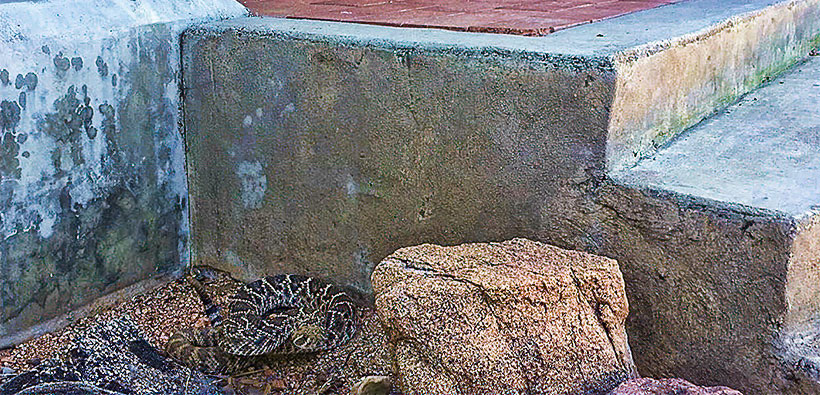When he’s not responding to 9-1-1 calls during his duty shift at Canyon Lake Fire/EMS, firefighter Brett Parker builds rattlesnake fences, teaches people not to harm snakes, and spreads the word that walking around Canyon Lake at dusk in the spring is risky as rattlesnakes slither onto driveways, streets and porches to warm up for the night.
The owner of Hill Country Snake Removal wants recreationalists to know that while there are snakes in Canyon Lake and the Guadalupe River, most of them non-venomous.
Parker urges residents to “kill the fear — not the snake,” and avoid going barefoot.
“It’s about my time of year again,” he told customers on his Facebook. “Snakes are on their way out from their winter hiding spots. If you would like an inspection/removal, or just want to learn more about local snakes give us a call.”
Unless he can safely relocate captured snakes within a mile of the home where they were found, Parker takes snakes to a property with others of the same species.
“The big thing I try to preach is not to get complacent,” Parker said. “Realize you’re living in Texas, and don’t just think that because you’re in a neighborhood you can walk around barefoot and not worry about the small chance there’s a rattlesnake. Watch where you’re walking.
“You won’t always hear a rattle,” he said. “Their first line of defense is to stay still quietly.”
New residents should not be complacent just because they’re surrounded by cement.
Spring is the time snakes end their “brumation,” a reptilian form of hibernation. Baby rattlesnakes are beginning to hatch, too. Just one female rattlesnake can have over 15 babies.
Something else to consider is snake-avoidance training for dogs. Parker said Two Rivers Kennels in New Braunfels offers classes for concerned pet owners.
But back to snake bites.
“Most of the time, people never see it coming,” he said.
Gardeners and homeowners are particularly at risk when they stick their hands into brush and plants without a clear line of sight.
Canyon Lake Fire/EMS doesn’t get a lot of snake calls, he said. In the United States, there are just 7,000 to 8,000 venomous snake bites reported each year.
If you do get bit, move away and try to get a photograph of the snake, Parker advises. Remove constrictive clothing or jewelry and position the affected limb above the heart.
Don’t use snake-bite kits sold at stores like Academy or try to suck the poison out of the wound.
Seek medical attention, preferably at a hospital, which is more likely to stock anti-venin than an urgent-care facility. There’s probably no need to call 9-1-1.
During private classes, Parker offers simple guidelines to help identify a snake and tell whether it’s venomous.
“You should always use multiple identifiers rather than believing your Uncle Steve that says, ‘if its head is triangular then it’s venomous.’”
“I always tell people if you know what a cottonmouth looks like, you know what a copperhead looks like, and you know what rattlesnakes and coral snakes look like, then you’re fine,” he said. “People have this idea that there are more venomous snakes than there actually are. Or that you can tell if a snake is venomous or not. A lot of people make IDs off of false information. There are a lot of bad ways to try and identify a snake. People talk about whether their pupils are vertical or horizontal. If you can see the pupils, you are too close to a snake.”
Coral snakes are popular topics of conversation on area social-media forums. If you’re thinking about red-touching-yellow then stop, Parker said. The rhyme is null-and-void in Comal County because the mimicking species, a milk snake, doesn’t live here.
If you do see a snake that’s red, yellow and black, it is a coral snake, but it’s also the least-dangerous venomous snake in the United States.
Coral snakes spend most of their life underground and pose little threat to humans or their pets unless stepped on, Parker said. Coral snakes are very timid and reluctant to bite.
“The Texas coral snake, unlike the rhyme, which states ‘red touch yellow, kills a fellow,’ hasn’t killed anyone in well over 50 years,” he said. “If you do happen to be somehow envenomated (bitten) by one, which is very difficult to accomplish, you should seek medical attention but will probably get nothing more than pain medication and observation. Anti-venom is usually not even warranted with that species.”
When he teaches his classes, Parker always reminds people they’re actually living in snakes’ homes, not the other way around.
“We live in their home, just like the deer and whatever other animals you’re going to come across,” he said. “You need to understand there are snakes around. You might not want to let your kids run around barefoot. Educate them about native wildlife.”
One of his best students is his nine-year-old daughter Alivia, who took a snake call when her dad was otherwise occupied.
She arrived at a Canyon Lake restaurant accompanied by her grandfather, walked in and announced she understood there was a snake “somewhere.”
Staff directed her to a box containing a little ball python.
“She casually explained to them what it was and reached in, picked it up, and then educated the staff on what identifying features led her to believe what it was and why it wasn’t dangerous,” Parker said. “So precious and I’m so stinkin’ proud of this little girl. Sheesh.”
Editor’s Note: This updated article originally appeared in April 2021.





So out at the lake in Potters Creek Park…what are we looking at over Here and when?